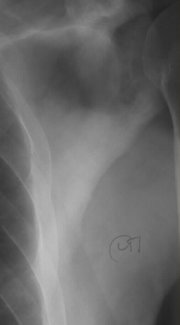Paget's disease of bone
Paget's disease, otherwise known as osteitis deformans, is a chronic disorder that typically results in enlarged and deformed bones. It is named after Sir James Paget, the British surgeon who first described this disease. The excessive breakdown and formation of bone tissue that occurs with Paget's disease can cause bone to weaken, resulting in bone pain, arthritis, deformities, and fractures. Paget's disease may be caused by a slow virus infection, present for many years before symptoms appear. There is also a hereditary factor since the disease may appear in more than one family member. more...
Paget's disease is rarely diagnosed in people under 40 years of age. Men and women are affected equally. Prevalence of Paget's disease ranges from 1.5 to 8 percent depending on age and country of residence. Prevalence of familial Paget's disease (where more than one family member has the disease) ranges from 10 to 40 percent in different parts of the world. Because early diagnosis and treatment is important, after age 40, siblings and children of someone with Paget's disease may wish to have an alkaline phosphatase blood test every 2 or 3 years. If the alkaline phosphatase level is above normal, other tests such as a bone-specific alkaline phosphatase test, bone scan, or x-ray can be performed.
Symptoms
Many patients do not know they have Paget's disease because they have a mild case with no symptoms. Sometimes, symptoms may be confused with those of arthritis or other disorders. In other cases, the diagnosis is made only after complications have developed. Symptoms can include:
- Bone pain is the most common symptom. Bone pain can occur in any bone affected by Paget's disease. It often localizes to areas adjacent to the joints.
- Headaches and hearing loss may occur when Paget's disease affects the skull.
- Pressure on nerves may occur when Paget's disease affects the skull or spine.
- Increased head size, bowing of limb, or curvature of spine may occur in advanced cases.
- Hip pain may occur when Paget's disease affects the pelvis or thighbone.
- Damage to cartilage of joints may lead to arthritis.
Diagnosis
Paget's disease may be diagnosed using one or more of the following tests:
- Pagetic bone has a characteristic appearance on x-rays.
- An elevated level of alkaline phosphatase in the blood can be suggestive of Paget's disease.
- Bone scans are Useful in determining the extent and activity of the condition. If a bone scan suggests Paget's disease, the affected bone(s) should be x-rayed to confirm the diagnosis.
Prognosis
The outlook is generally good, particularly if treatment is given before major changes in the affected bones have occurred. Any bone or bones can be affected, but Paget's disease occurs most frequently in the spine, skull, pelvis, thighs, and lower legs. In general, symptoms progress slowly, and the disease does not spread to normal bones. Treatment can control Paget's disease and lessen symptoms but is not a cure. Osteogenic sarcoma, a form of bone cancer, is an extremely rare complication that occurs in less than one percent of all patients.
Other medical conditions
Paget's disease may lead to other medical conditions, including:
Read more at Wikipedia.org



